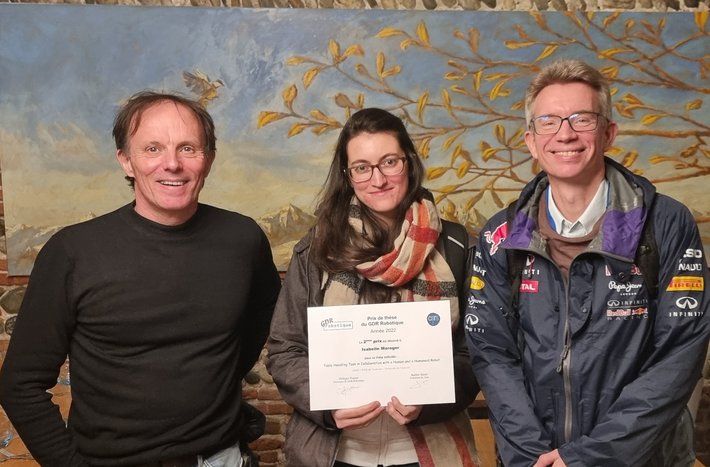Year of defence: 2022
Manuscript available here
Abstract
To improve human-robot collaborations, more and more researches focus on the study of human behaviour. It is in this context of growing relationships between robotics and biomechanics that theCollaBorative roBot (CoBot) project has emerged. Funded by the French Agence Nationale de la Recherche (ANR), this project (ANR-CoBot) targets a human-humanoid robot collaboration in the context of a load-carriage task. During this collaboration, the robot is aimed to safely and pro-actively assist its human partner to handle a load. The idea of the ANR-CoBot project is, first, to understand the mechanisms at stake during a human-human collaboration and, then, to model and simulate them to finally implement them on a humanoid robot TALOS from PAL Robotics to perform the same task with a human partner.As part of this project, my PhD deals with the transition from the modelling of the human behaviourto the integration of this model in a humanoid robot. The final goal of this thesis is to perform a pro-active human-robot interaction to carry a table. From a biomechanics point of view, my thesis aims to better understand human locomotion in order to enable the robot to anticipate its partner’s behaviour. To achieve this goal, experiments were performed to measure Center of Mass (CoM) human trajectories, first during simple locomotion and then during carriage task. Then, models based on optimal control problems were designed to generate human-like trajectories or even predict them. This prediction may improve the human-robot interactions making the robot acting pro-actively. Then, from a robotics point of view, to achieve a collaborative carriage task, five matters need to be handled:• Localization: the robot needs to locate the table and its human partner in order to interactwith them.• Walk generation: the robot needs to walk toward the table at the beginning of theexperiment and also needs to walk with the table towards an unknown location chosenby its human partner.• Whole-body control: the robot needs to lift the table and handle it while walking.• Balance: the robot should not fall during the experiment.• Safety: the robot should not harm its human partner.Among those matters, my thesis mainly focuses on the walk generation. The other topics are handled by other members of the Gepetto team in LAAS-CNRS. One major contribution of my thesis is to embed the prediction trajectory model into the robot walking pattern generator. This aims to improve the human-robot interaction for two main reasons. First, it may allow the robot to be more reactive by anticipating its partner motions and, then, it may make the interaction less disturbing and more natural for the human as the robot may act in a human-like manner.
Publications
Award
Isabelle received the second prize of the best PhD in Robotics for the year 2022.
